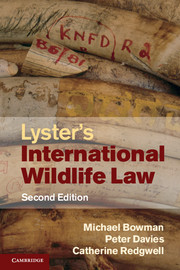Description
Lyster's International Wildlife Law (2nd Ed., Revised edition)
Authors: Bowman Michael, Davies Peter, Redgwell Catherine
Explores the key international treaty instruments regulating species conservation and habitat protection, and the mechanisms available to make them work.
Language: English
Subject for Lyster's International Wildlife Law:
Approximative price 49.66 €
In Print (Delivery period: 14 days).
Add to cart
Lyster's International Wildlife Law
Publication date: 12-2010
784 p. · 15.4x22.7 cm · Paperback
Publication date: 12-2010
784 p. · 15.4x22.7 cm · Paperback
Approximative price 143.25 €
In Print (Delivery period: 14 days).
Add to cart
Lyster's International Wildlife Law (2nd Ed.)
Publication date: 12-2010
784 p. · 15.8x23.4 cm · Hardback
Publication date: 12-2010
784 p. · 15.8x23.4 cm · Hardback
Description
/li>Contents
/li>Biography
/li>
The development of international wildlife law has been one of the most significant exercises in international law-making during the last fifty years. This second edition of Lyster's International Wildlife Law coincides with both the UN Year of Biological Diversity and the twenty-fifth anniversary of Simon Lyster's first edition. The risk of wildlife depletion and species extinction has become even greater since the 1980s. This new edition provides a clear and authoritative analysis of the key treaties which regulate the conservation of wildlife and habitat protection, and of the mechanisms available to make them work. The original text has also been significantly expanded to include analysis of the philosophical and welfare considerations underpinning wildlife protection, the cross-cutting themes of wildlife and trade, and the impact of climate change and other anthropogenic interferences with species and habitat. Lyster's International Wildlife Law is an indispensable reference work for scholars, practitioners and policy-makers alike.
Part I. Foundations of International Wildlife Law: 1. The historical evolution of international wildlife law; 2. Wildlife and the international legal system; 3. The philosophical foundations of international wildlife law; 4. Implementation and enforcement of international wildlife law; Part II. Species Regulation: 5. Fish; 6. The International Convention for the Regulation of Whaling; 7. Birds; Part III. Regional Wildlife Regulation: 8. The Convention on Nature Protection and Wildlife Preservation in the Western Hemisphere; 9. The African Convention on the Conservation of Nature and Natural Resources; 10. The Convention on the Conservation of European Wildlife and Natural Habitats; 11. Polar regions; 12. Other regional and sub-regional arrangements; Part IV. Global Wildlife Regulation: 13. The Ramsar Convention on Wetlands; 14. World Heritage Convention; 15. The Convention on International Trade in Endangered Species of Wild Fauna and Flora; 16. The Convention on the Conservation of Migratory Species of Wild Animals; Part V. Biological Diversity: A New Perspective on Wildlife Regulation: 17. The Biodiversity Convention and biosafety protocol; 18. Deserts, forests and mountains; Part VI. Cross-Sectoral Issues in Wildlife Regulation: 19. Wildlife and trade; 20. Wildlife and welfare; 21. Wildlife and pollution; Part VII. Conclusion: 22. Final reflections.
Michael Bowman is Associate Professor at the School of Law, University of Nottingham, where his principal teaching and research interests lie in public international law, particularly international environmental and treaty law.
Peter Davies is Associate Professor at the School of Law, University of Nottingham, where his main teaching and research interests lie in international environmental law and European Union environmental law.
Catherine Redgwell is Professor of International Law at University College London, where her main teaching and research interests lie in international environmental and energy law.
Peter Davies is Associate Professor at the School of Law, University of Nottingham, where his main teaching and research interests lie in international environmental law and European Union environmental law.
Catherine Redgwell is Professor of International Law at University College London, where her main teaching and research interests lie in international environmental and energy law.
© 2024 LAVOISIER S.A.S.
These books may interest you

Wildlife Issues in a Changing World 271.33 €

Climate Justice and Disaster Law 40.64 €

Climate Justice and Disaster Law 122.57 €

